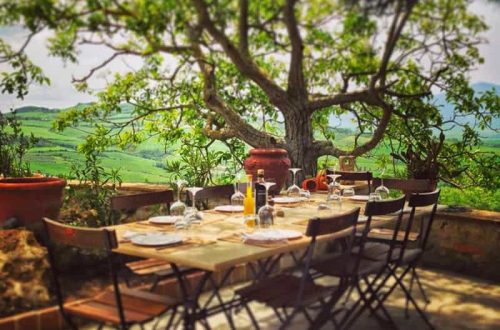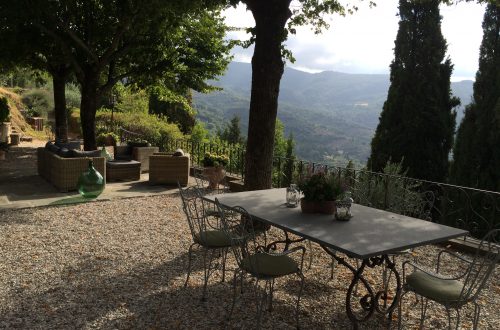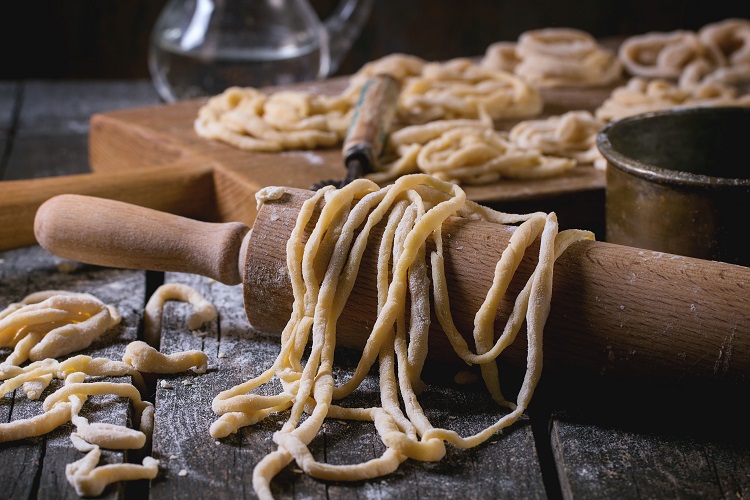
Make Tuscan Pici Pasta at Home
Pici are essentially fat, hand-rolled spaghetti. The name comes from Tuscany, and it has a lookalike in Umbria the locals call stringozzi. The pasta is also seen in Emilia-Romagna, too. It is a rustic and irregular pasta, which makes it a great shape for beginners.
According to the Encyclopedia of Pasta, most versions of pici or stringozzi use a combination of flours: The Tuscans often add some semolina flour, and the Umbrians often use farro flour. It makes the pasta a little rougher, which helps when you roll it out by hand.
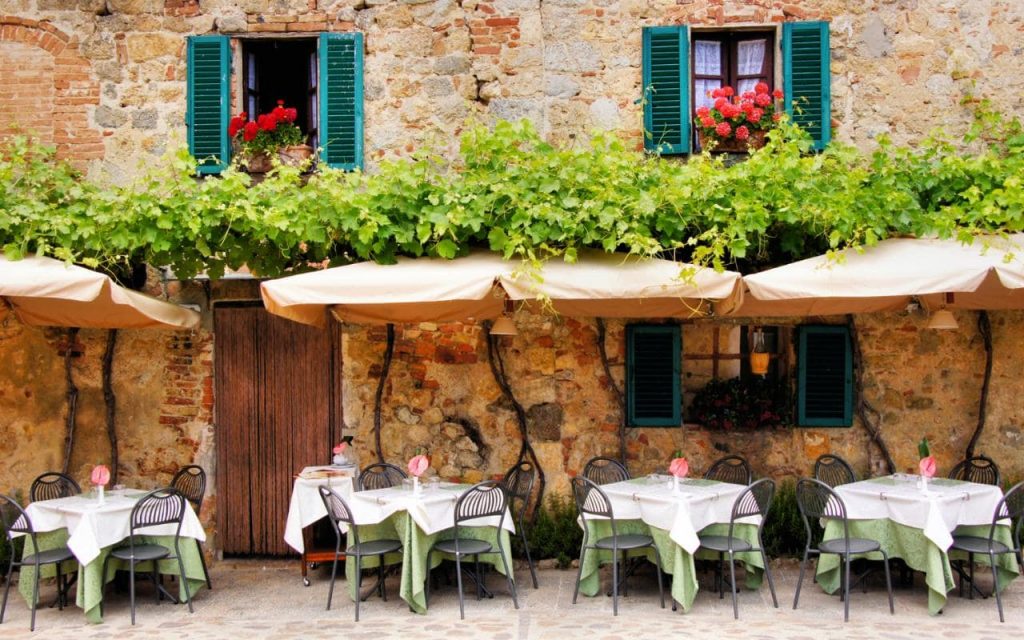
Making Pici Pasta at Home
A little olive oil is also often added to the dough, as are eggs on occasion. My recipe for pici pasta dough does not use eggs.
Serves 4.
Prep Time: 1 hour
Cook Time: 5 minutes
- 1 cup semolina flour
- 1 3/4 cups all-purpose flour
- 1 tablespoon olive oil
- A pinch of salt
- 7/8 cup water
Whisk together the flours and salt in a large bowl, then make a well in center. Pour in the oil and water and start incorporating it into the dough with a fork. When it becomes a shaggy mass, pull the dough off the fork and start kneading by hand. Knead for a good 5-8 minutes — I pass the time by counting two or three songs on the radio.
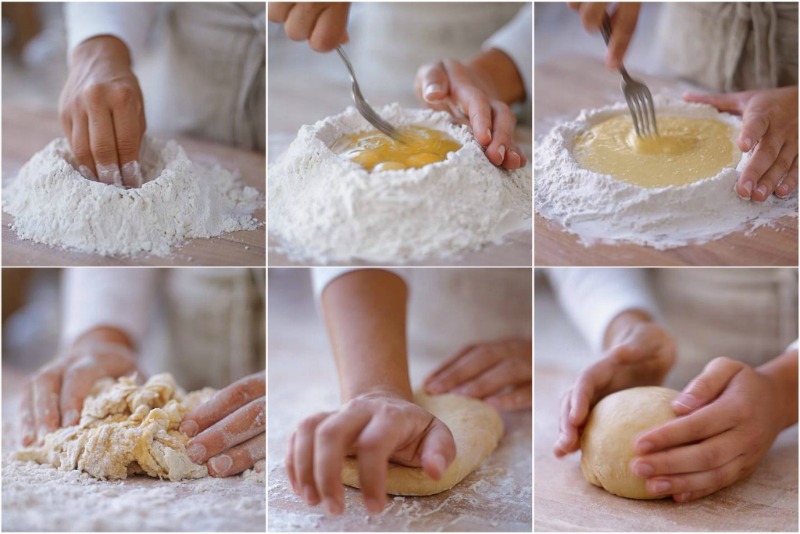
Cover the pasta with plastic wrap and let it sit on the counter for an hour, or put it in the fridge for up to a day.
When you are ready to make the pici, form the pasta dough into a shape that can be cut into 4-6 even pieces. Cut the pieces and cover them all with the plastic wrap.
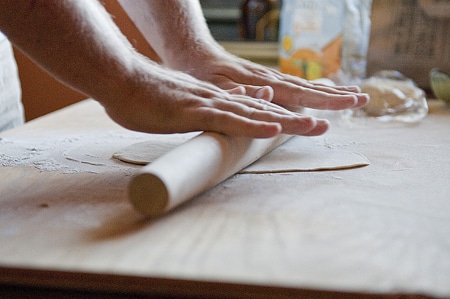
First thing to do when rolling out pici is to flatten your piece of dough with your hand.
Now make sure it is well floured on both sides. Roll it out with a pin, an Italian pasta rolling pin if possible. A pasta pin does not have rollers and is longer than a regular pin. This gives you more control and allows you to roll out large, thin sheets of pasta by hand.
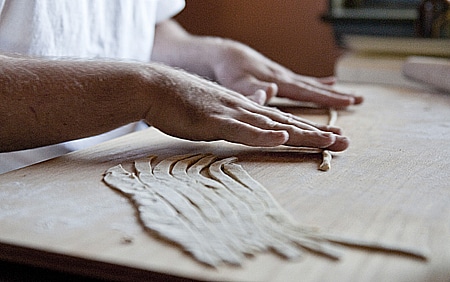
You see how thick the pasta is in the picture? That’s what you want. Nothing overly thin — about 1/8 to even 1/4 inch is fine.
Now you slice the pasta into 1/4 inch lengths. It does not matter if some are longer than the others
Here’s how you make the pici. You work from the outside of the slices inward. This keeps them as moist as possible by limiting air contact with the edges. If you are in a dry environment or are just learning to make this shape, cover the slices you are not working on with a cloth or plastic wrap.
Unlike many pasta shapes, you do not want too much extra flour around when making pici. You want everything to be a little tacky, which helps you roll easier.
Take a slice and pinch it from a flat noodle to something roughly approximating square or round. Key word “rough,” as you are only doing this to make it easier to roll the pasta with your hands.
Now, with your hands flat, roll the pasta from the center outwards rapidly.
If the pasta is moist enough, you will get a nice roll immediately. Keep rolling it out — center to edges — until the pasta is about 1/4 to 1/6 of an inch in diameter. Pici are supposed to be fat, but the skinnier you can make them, the better.
Make sure you extend your hand out past the edge of the pasta when you roll — this prevents the ends from being fatter or flatter than the center of the pici. Still, fat ends happen. If you do have one, you can concentrate on just that side. Be careful you do not stress the rest of the pasta enough to break it.
A finished pici should be at least eight inches long, and you can make them up to about 18 inches long. Any longer and they get tricky to dry and eat.
They will be irregular, which is the point, and the surface should be rough, which helps the sauce adhere to it.
As you make the pasta, lay them out on a cookie sheet dusted with cornmeal or semolina pasta. When you complete a sheet, cover it with a cloth. This recipe makes two large cookie sheets’ worth.
Boil the pici in lots of salty water for 2 to 3 minutes. Once they float, boil for another minute or two. Be sure to have your sauce already done before you put the pasta in the water.
What to sauce pici with? In Tuscany, pici are usually served with a tomato sauce or with a duck or cinghale (wild boar) ragu.
Eat your pici the day you make them. They get brittle and break if you try to store them. Besides, once you get the hang of it, making pici doesn’t take much longer than it does to make a homemade tagliatelle or spaghetti — maybe 45 minutes to an hour, once you have the dough ready.
One of the coolest things about this pasta is that it requires no special equipment: You don’t even need a pasta rolling machine, and even the rolling pin, while useful, can be replaced by an empty wine bottle. And if you don’t have an empty wine bottle lying around, well, there’s only one way to empty it — salud!




